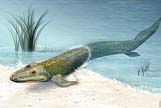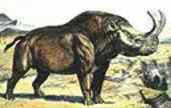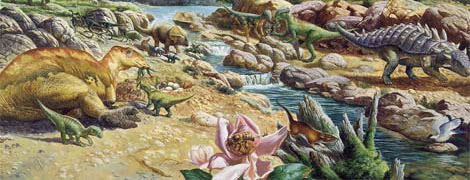 |
 |
 |
 |
 |
Produced
by the Population Genetics and Evolution class, Furman University |
||||
 |
 |
 |
 |
 |
Produced
by the Population Genetics and Evolution class, Furman University |
||||
 |
The
Cretaceous: Triceratops |
 |
||
| Triceratops,
which literally means “three-horned face”, was one of the
most numerous of the horned dinosaurs (Dinosaur Corporation 1997). It
was first discovered by John Bell Hatcher in Colorado in 1888, and was
originally identified as a buffalo. However, there is still some disagreement
concerning the fossils of Triceratops; some specialists believe
that there was only one species, but others argue that there were at least
two different species (The Big Zoo 2010). One of the most distinctive
features of Triceratops is the three horns on the top of their
head. They had one short horn above their beak, and 2 longer ones on their
brow. It is thought that these horns were probably used for protection,
and they may have even been used in mating rituals (Col 2009). These horns,
along with their thick, rough skin, served to protect them from their
main predator, Tyrannosaurus rex. Unlike their predators though,
Triceratops were herbivores. While their beak did not contain
any teeth, they had cheek teeth and powerful jaws that were used for chewing
the plant material. Another characteristic of these creatures is that
they had very large heads, which were about 1/3 of their body size (Dinosaur
Corporation 1997). They also had a short, pointy tail and a bulky body
(The Big Zoo 2010). They walked on four short legs and were about 25 feet
long, weighing about 2 tons (Dinosaur Corporation 1997).
Page by Lindsay Gerzel |

|
| Triceratops prorsus. Picture From: Dinosaur Timeline Gallery. | |
|
Col J. 2009. Triceratops horridus: “horrible three-horned face”. Accessed April 5, 2010. Dinosaur Corporation. 1997. Triceratops prorsus. Accessed April 5, 2010. The Big Zoo. 2010. Triceratops: Triceratops horridus. Accessed April 5, 2010. |